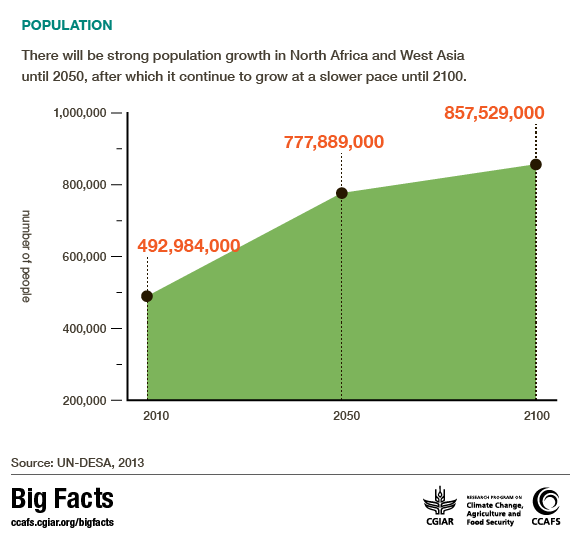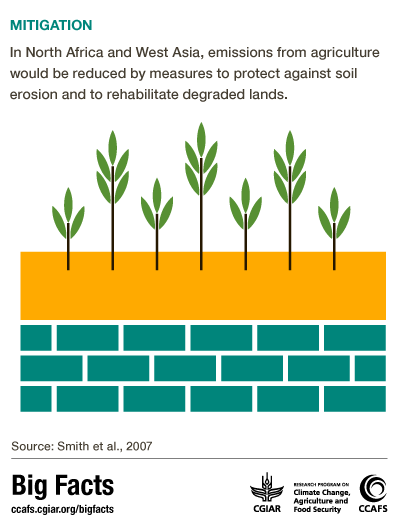Big Facts: Focus on North Africa and Western Asia

This story spotlights some of the Big Facts on North Africa and Western Asia, and is part of a special blog series to complement the new Big Facts infographics website.
In the region comprising Northern Africa and the Middle East, climate change will likely cause a decrease in rainfall and an accompanying decrease in the area suitable for rainfed agriculture (Evans, 2009). In an area already suffering from water scarcity, this could have serious effects on the food security of the region. Climate change in the region will interact with other problems, such as high population growth and political instability, further complicating the situation.
Food Security

Food security is extremely complex in the region of North Africa and Western Asia; 6.5% of the population suffers from undernourishment (FAO, 2013), while at the same time, 43.8% of the population are overweight (WHO, 2008). Undernourishment and obesity are not confined to specific areas, but can exist side-by-side within the same country, region or even city, making it harder to deal with the consequences of the two forms of malnutrition. Here, we see communities faced with a “double burden” of disease, as they struggle to deal with both undernourishment and obesity at the same time (WHO, 2008).
Impacts on crops
North Africa and Western Asia is largely an arid region, making it increasingly vulnerable to climate-induced impacts on water resources, and it is considered one of the most vulnerable regions to climate change impacts, due to its water scarcity (Elasha, 2010:13). Already today, many areas in the region are experiencing a severe water deficit, which is only expected to worsen by 2050. The water flow of the Euphrates and Jordan Rivers could shrink by as much as 30% and 80%, respectively, over the coming century (IPCC, 2012).
Though much can be done to adapt to the changed circumstances, the increasing water scarcity combined with increasing populations could lead to conflicts. As Sowers and Weinthal (2010) point out, the negative impacts of climate change on water availability can be used as an excuse for unilateral interventions dealing with water resources. However, adaptation measures can be included in institutional arrangements dealing with river basins, for example through establishing transboundary river commissions. It is therefore important to support such efforts to strengthen regional governance of water resources to avoid these potential conflicts.

Besides increasing water scarcity, climate change is also expected to have a negative effect on crop yields in the region, which could face yield declines of up to 30% for rice, about 47% for maize and 20% for wheat (IPFRI, 2009). But yield declines will not be consistent across the region. Ray et al. (2013: 5) found that wheat yields are increasing at doubling rates in parts of Iraq, Iran, and Afghanistan. In contrast, they found that decreases in per capita harvests could occur in Afghanistan, Georgia, Iraq, Kyrgyzstan, Saudi Arabia, and Yemen, partly as a result of population growing faster than yields.
Rangeland-based systems are the predominant livestock production system in most of the arid zones in the region. However, increasing temperatures and changes to precipitation patterns could force farmers to abandon the rangelands in the semi-arid and arid zones as productivity declines (FAO, 2012). Fisheries in the region will also be affected by changing climate, as the Persian Gulf is expected to lose a high percentage of wild caught fisheries (Huelsenbeck, 2012).
Impacts on People
The majority of drylands are used as rangelands, with some 828 Mha in Western Asia and North Africa alone. Due to climate change, these areas will face both increasing temperatures and less, or more infrequent, rain. In dry areas, these changes will hit the rural poor hard, and a range of coping strategies will be required to help them adapt to changing climates (Thomas, 2008). The region has a long tradition of mobility (due to the nomadic people as well as the geographic location), and migration as response to additional climatic stresses is considered a probable outcome of the changes (Brucker et al., 2012).
Adaptation:
Mobility has always been an important strategy for farmers coping with climatic variability in the region, and will become even more important than ever before under climate change. Pastoralists will need to shift the areas used for livestock to adapt to changing water availability and pasture productivity (van de Steeg and Tibbo 2012).
 Karrou and Oweis (2011) found that adaptation strategies to deal with water scarcity in the region include: (1) supplemental irrigation (e.g. irrigation for traditionally rainfed crops, timed to avoid water stress during critical stages such as flowering and/or grain filling); (2) water harvesting (e.g. collecting water in small reservoirs to use in dry periods); and (3) practices to reduce irrigation requirements (e.g. deficit irrigation and raised-bed planting). Plant breeding will also become an important strategy to cope with droughts and water scarcity, as this can help to ‘climate-proof’ some crops, by making them more tolerant to climate-related stresses, such as extreme heat and prolonged periods of drought (Sharma et al., 2011).
Karrou and Oweis (2011) found that adaptation strategies to deal with water scarcity in the region include: (1) supplemental irrigation (e.g. irrigation for traditionally rainfed crops, timed to avoid water stress during critical stages such as flowering and/or grain filling); (2) water harvesting (e.g. collecting water in small reservoirs to use in dry periods); and (3) practices to reduce irrigation requirements (e.g. deficit irrigation and raised-bed planting). Plant breeding will also become an important strategy to cope with droughts and water scarcity, as this can help to ‘climate-proof’ some crops, by making them more tolerant to climate-related stresses, such as extreme heat and prolonged periods of drought (Sharma et al., 2011).
Mitigation
Restoration of degraded lands and prevention of soil erosion will be an important mitigation option in the region (Smith et al., 2007). It is important do stop this degradation and erosion of soil, as it undermines food productivity and causes the release of GHGs.

Similar to other regions, the North Africa and West Asia region is facing serious challenges from climate change in the coming century. Because of its location and geography, many of these challenges revolve around water. To deal with climate change, the young and growing population of the region will first have to deal with water issues – as a largely arid region, it is all the more vulnerable to climate change impacts on water resources, making adaptation, good governance, and efficient utilization of resources key to success.
HAVE YOUR SAY
Because of the inherent uncertainties of climate change, even our best predictions of those future changes are more or less uncertain. With Big Facts, we have tried to collect the best, most scientifically thorough and up-to-date research in various areas. I encourage you to explore the data on the North Africa and West Asia page of the Big Facts website and to consult the various references, if you would like to know more. Should you have any comments on any of the findings, these are more than welcome.
We invite you to browse the facts; compare the various regions to each other or narrow down on a specific topic, the options are numerous. If you have any questions or comments, feel free to post these below or send an email.
Now you can get all the Big Facts on the links between climate change, agriculture and food security at ccafs.cgiar.org/bigfacts2014. The new site features over 100 stunning infographics that illustrate the most up-to-date, thoroughly researched information on these topics.
Big Facts is also an open-access resource. You can download and share the graphics with your friends and colleagues and use them in your presentations and reports. Please do not hesitate to send us any suggestions for improvements, either by commenting below or sending us an email.
This story is part of a series focusing on the Big Facts on various topics and in different regions; join the conversation at ccafs.cgiar.org/blog and on twitter using #bigfacts
